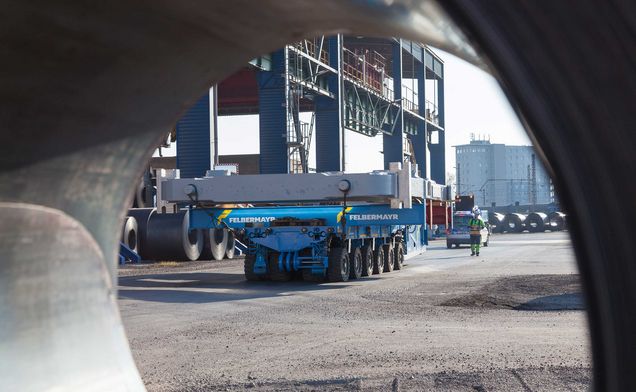Heavy haulage and installation for a cold levelling machine
April 29, 2019 | Markus Lackner
A self-propelled transporter,a lifting frame and a mobile crane as well as forklift trucks and work platforms were used to transport and position the two roll stands, each weighing 130 tonnes, on their foundations. But this was only possible through the know-how of all the companies and their staff involved in this operation. “Planning for this project started about a year ago”, stated Herbert Gruber who works for Felbermayr in Linz, illustrating the large amount of time devoted to this project.
Self-propelled transporter with a six metre transport width
A six-axle self-propelled transporter was used for moving the stands inside the steel mill. This was needed to provide the stands measuring six metres wide and over ten metres long with sufficient bearing surface. Its engine developed 478 hp, enough power, therefore, to move the 130 tonne roll stands to their destination from where they were manufactured just a few kilometres away.
Large measures of skill and dexterity were needed to “park” the self-propelled transporter within a centimetre of its appointed place in the cold rolling mill’s production bay. And once it was in there some final manoeuvring was needed before it was possible to place the load in its correct position in front of the lifting frame. This would have been impossible without the ability of sideways movement - of rotating at a standstill.
Tandem lift with a lifting frame and truck-mounted crane
Shortage of space and the internal height of the bay of about twelve metres called for a technically challenging solution for rotating and then lifting the roll stands which were about ten metres high. “We solved the problem with a combination of the lifting frame and a mobile crane”, said Hubert Gruber, who then went on to explain the sequence in detail: “The head section of the roll stand was first fastened to the cross-beam of the lifting frame; the crane’s hook block was then connected to the lower part of this steel heavyweight. The next step was to lift the head section slowly, followed by moving the rail-mounted ram of the lifting frame towards the foundation. While this was going on, the crane guided the lower part step by step up to the mounting point where it was finally lowered onto the mounting points.” Each lift lasted about one and a half hours until the stands were finally in position on their foundations.
voestalpine in Linz, who is the world market-leader in this field, was already capable of processing roll-bonded clad plates up to 20 mm thick. When the new plant is finished it will be possible to level plates even up to 80 mm thick. Amongst other applications, the acid-resistant places are used in the manufacture of pipes for pipeline construction, the foodstuffs industry and seawater desalination plants.









